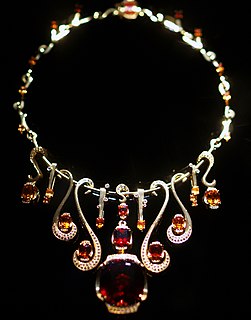 W
WA necklace is an article of jewellery that is worn around the neck. Necklaces may have been one of the earliest types of adornment worn by humans. They often serve ceremonial, religious, magical, or funerary purposes and are also used as symbols of wealth and status, given that they are commonly made of precious metals and stones.
 W
WThe Affair of the Diamond Necklace was an incident from 1784 to 1785 at the court of King Louis XVI of France that involved his wife, Queen Marie Antoinette.
 W
WBali-og, also spelled baliog, are traditional layered necklaces of various ethnic groups in the islands of Visayas and Mindanao in the Philippines. They consist of chokers and necklaces with a fringe of beads and other ornaments. More than one is usually worn, layered over each other. Their elements usually consist of metal or glass beads, hollowed seeds, seashells, mother-of-pearl, and copper or brass ornaments.
 W
WA bulla, an amulet worn like a locket, was given to male children in Ancient Rome nine days after birth. Rather similar objects are rare finds from Late Bronze Age Ireland.
 W
WA choker is a close-fitting necklace worn around the neck, typically 14 inch to 16 inch in length. Chokers can be made of a variety of materials, including velvet, plastic, beads, latex, leather, metal, such as silver, gold, or platinum, etc. They can be adorned in a variety of ways, including with sequins, studs, or a pendant.
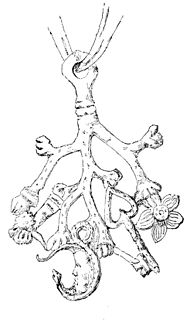 W
WThe cimaruta is an Italian folk amulet or talisman, traditionally worn around the neck or hung above an infant's bed to ward off the evil eye. Commonly made of silver, the amulet itself consists of several small apotropaic charms, with each individual piece attached to what is supposed to represent a branch of rue—the flowering medicinal herb for which the whole talisman is named, "cimaruta" being a Neapolitan form of cima di ruta: Italian for "sprig of rue".
 W
WIn jewelry, a collar is an ornament for the neck.
 W
WAn encolpion is a medallion with an icon in the center worn around the neck by Orthodox and Eastern Catholic bishops. The icon is normally surrounded by jewels and topped by an Eastern-style mitre. It often also has a small jewelled pendant hanging down at the bottom. The engolpion is suspended from the neck by a long gold chain, sometimes made up of intricate links. A portion of the chain will often be joined together with a small ring behind the neck so that it hangs down the back. Engolpia come in many different shapes, including oval, rhombus, square, or a double-headed eagle. In antiquarian contexts, an "encolpion cross" is a pectoral cross of the Byzantine period.
 W
WThe Gleninsheen gorget is a late Bronze Age collar, found in 1930 in the Gleninsheen region of the Burren, County Clare, Ireland. Given that the gorget is made from gold and weighs 276 g (8.9 ozt) it must have been intended as an ornament for a high-ranking warrior. Dated to c. 800–700 BC, it is one of the earliest examples of substantial Irish goldwork.
 W
WThe Gold lunula is a distinctive type of late Neolithic, Chalcolithic or early Bronze Age necklace or collar shaped like a crescent moon. They are normally flat and thin, with roundish spatulate terminals that are often twisted to 45 to 90 degrees from the plane of the body. Gold lunulae fall into three distinct groups, termed Classical, Unaccomplished and Provincial by archaeologists. Most have been found in Ireland, but there are moderate numbers in other parts of Europe as well, from Great Britain to areas of the continent fairly near the Atlantic coasts. Although no lunula has been directly dated, from associations with other artefacts it is thought they were being made sometime in the period between 2200–2000 BC; a wooden box associated with one Irish find has recently given a radiocarbon dating range of 2460–2040 BC.
 W
WA Jesus piece is a spiritual or religious piece of jewelry that is popular in the hip hop community and depicts the face of Jesus. Many hip hop artists and celebrities, including The Notorious B.I.G., Jay-Z, Kanye West among others, have adopted the Jesus piece as a common fashion accessory and have them decorated with many precious gems. Cheaper Jesus pieces have also been sold in other materials including wood and inexpensive metals. Traditional medals in Western Christianity that are worn as necklaces have depicted the Holy Face of Jesus.
 W
WKalabubu, sometimes spelled Kala bubu, is a torc worn by warriors of the people of South Nias of North Sumatra, Indonesia. Kalabubu symbolizes triumph in warfare and heroism. Wearing a kalabubu was believed to protect the wearer from harm. Kalabubu is popularly known as the "headhunter's necklace"; historically only those who already decapitated the head of the enemy tribes are allowed to wear the kalabubu.
 W
WA lamen is a magical pendant or breastplate worn around the neck so that it hangs upon the breast over the heart. Its uses vary but, most commonly, the term refers to a symbol of authority and a focus of magical energies. Aleister Crowley described the lamen as "a sort of coat of arms. It expresses the character and powers of the wearer." Crowley and DuQuette have proposed that the magical lamen might be a modern adaptation of the priestly breastplate of the ancient Hebrews.
 W
WA lavalier or lavaliere or lavalliere is an item of jewellery consisting of a pendant, sometimes with one stone, pendulous and centered from a necklace.
 W
WA lei is a garland or wreath common in Hawai'i and across Polynesia. More loosely defined, a lei is any series of objects strung together with the intent to be worn. Lei of various styles are given as gifts to honour people throughout the Pacific, being presented, for example, to visiting dignitaries, graduates, or to loved ones who are departing.
 W
WA Lei niho palaoa is a Hawaiian neck ornament traditionally worn by aliʻi (chiefs) of both sexes. The 19th century examples are most commonly made of a whale tooth carved into a hook-shape suspended by plaited human hair. The symbolism is not known; it may represent a tongue that speaks the law, or may represent a vessel for mana. Precontact lei niho palaoa were less than two inches in length, and were not only made of whale ivory, but also of shell, bone, wood, stone, and coral. Sometimes, several of these smaller pendants were strung on twisted human hair. The Bishop Museum has a lei niho palaoa with a hair bundle having a circumference of 7.5 inches. It is made from a single eight-ply square braid cord, measuring 1,708 feet, looped back and forth over 1000 times on each side.
 W
WThe "Amulets of Ancient Egypt" fall in approximately seven major categories:Amulets of gods/goddesses and sacred animals Amulets of protection The scarab for the living, Amulets of assimilation Amulets for powers Amulets of possessions, property, or as offerings (symbolism of materials)
 W
WA livery collar or chain of office is a collar or heavy chain, usually of gold, worn as insignia of office or a mark of fealty or other association in Europe from the Middle Ages onwards.
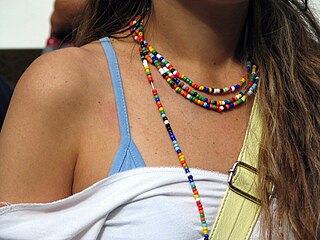 W
WLove beads are one of the traditional accessories of hippies. They consist of one or more long strings of beads, frequently handmade, worn around the neck by both sexes. The love bead trend probably evolved from the hippie fascination with non-Western cultures, such as those of Africa, India, and Native America, which make common use of similar beads.
 W
WA lunula was a crescent moon shaped pendant worn by girls in ancient Rome. Girls ideally wore them as an apotropaic amulet, the equivalent of the boy's bulla. In the popular belief the Romans wore amulets usually as a talisman, to protect themselves against evil forces, demons and sorcery, but especially against the evil eye.
 W
WMadaka, also written as mendaka, is a type of precious metal valuable to the Sumba people of Sumba Island, Indonesia. It is found in the megalithic culture of the western Sumba people, e.g. the tribe of Anakalang. Of all precious metal valuable to Sumba people, the madaka is considered to be the most sacred type of gold heirloom.
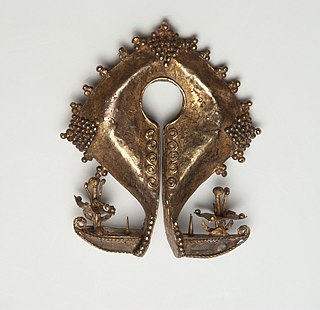 W
WMamuli are precious metal ornaments of the Sumba people, Sumba, Indonesia. They are found in the megalithic society of the western Sumba people, e.g. the Anakalang society. The mamuli ornaments have a shape which represents the female genitalia, symbolizing the woman as the giver of life. Mamuli are the most important Sumbanese precious metal valuables and are seen as heirloom objects which served in important exchange rituals.
 W
WA mangala sutra or thaali is a necklace that the groom ties around the bride's neck in the Indian subcontinent, in a ceremony called Mangalya Dharanam. The necklace serves as a visual marker of status as a married woman.
 W
WMarangga are precious metal valuable of the Sumba people of Sumba Island, Indonesia. They are found in the megalithic culture of the western Sumba people, e.g. the Anakalang society. They have the shape of a twisted metal sheet with a broadened end that has the shape of an axe. The marangga of Sumba is worn hung to the neck as a pendant, forming a kind of chest plate.
 W
WNeck rings, or neck-rings, are any form of stiff jewellery worn as an ornament around the neck of an individual, as opposed to a loose necklace. Many cultures and periods have made neck rings, with both males and females wearing them at various times.
 W
WThe Necklace of Harmonia, also called the Necklace of Eriphyle, was a fabled object in Greek mythology that, according to legend, brought great misfortune to all of its wearers or owners, who were primarily queens and princesses of the ill-fated House of Thebes.
 W
WA pendant is a loose-hanging piece of jewellery, generally attached by a small loop to a necklace, which may be known as a "pendant necklace". A pendant earring is an earring with a piece hanging down. Its name stems from the Latin word pendere and Old French word pendr, both of which translate to "to hang down". In modern French, pendant is the gerund form of pendre and also means "during". The extent to which the design of a pendant can be incorporated into an overall necklace makes it not always accurate to treat them as separate items.
 W
WA posture collar is a rigid collar used in BDSM and fetish play that is wide enough to restrict movement of the neck. Posture collars help in maintaining posture, keeping the chin high and the neck extended. Posture collars typically flare widely at the front to reach from the chin to the collarbone, preventing the wearer from hanging their head or looking downward.
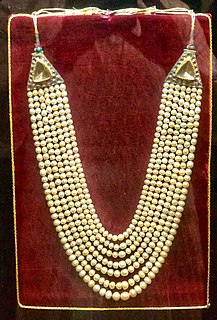 W
WSatlada is a seven stringed pearl necklace of Indian origin. It traditionally has 465 pearls embedded in it. It can also be set with emeralds, diamonds and rubies.
 W
WShell gorgets are a Native American art form of polished, carved shell pendants worn around the neck. The gorgets are frequently engraved, and are sometimes highlighted with pigments, or fenestrated.
 W
WThe Shropshire bulla is a Late Bronze Age gold pendant found by a metal detectorist in 2018 in Shropshire, England. Made primarily of gold, it is the eighth bulla discovered to date in Great Britain and Ireland, and only the second in Britain. The pendant, decorated with intricately carved geometric designs, is now in the British Museum in London.
 W
WA torc, also spelled torq or torque, is a large rigid or stiff neck ring in metal, made either as a single piece or from strands twisted together. The great majority are open at the front, although some had hook and ring closures and a few had mortice and tenon locking catches to close them. Many seem designed for near-permanent wear and would have been difficult to remove. Torcs are found in the Scythian, Illyrian, Thracian, Celtic, and other cultures of the European Iron Age from around the 8th century BC to the 3rd century AD. For the Iron Age Celts, the gold torc seems to have been a key object. It identifies the wearer as a person of high rank, and many of the finest works of ancient Celtic art are torcs. The Celtic torc disappears in the Migration Period, but during the Viking Age torc-style metal necklaces, now mainly in silver, came back into fashion. Torc styles of neck-ring are found as part of the jewellery styles of various other cultures and periods.
 W
WAs early as the Old Kingdom, Egyptian artisans fashioned images of gods, kings, and mortals wearing broad collars made of molded tubular and teardrop beads. Broad collar, Senebtisi The Usekh or Wesekh is a personal ornament, a type of broad collar or necklace, familiar to many because of its presence in images of the ancient Egyptian elite. Deities, women, and men were depicted wearing this jewelry. One example can be seen on the famous gold mask of Tutankhamun. The ancient word wsẖ can mean "breadth" or "width" in the Ancient Egyptian language and so this adornment is often referred to as the broad collar.